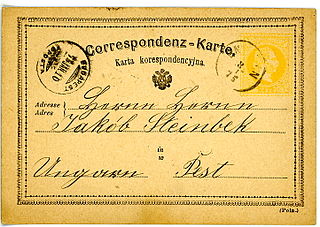
Postal cards are postal stationery with an imprinted stamp or indicium signifying the prepayment of postage. They are sold by postal authorities. On January 26, 1869, Dr. Emanuel Herrmann of Austria described the advantages of a Correspondenz Karte. By October 1, 1869 the world's first postal card was produced by Austria-Hungary. They caught on quickly. By the end of 1870, Great Britain, Finland, Switzerland and Württemberg joined the countries issuing postal cards. In the United States, they were first produced in 1873. Some of the forms taken by postal cards include the regular single card which may be commemorative or definitive, attached message-reply cards, airmail postal cards, and official postal cards used for official government business with a "penalty for private use".

The Penny Black was the world's first adhesive postage stamp used in a public postal system. It was first issued in Great Britain on 1 May 1840, but was not valid for use until 6 May. It features a profile of Queen Victoria.

The Uniform Penny Post was a component of the comprehensive reform of the Royal Mail, the UK's official postal service, that took place in the 19th century. The reforms were a government initiative to eradicate the abuse and corruption of the existing service. Under the reforms, the postal service became a government monopoly, but it also became more accessible to the British population at large through setting a charge of one penny for carriage and delivery between any two places in the United Kingdom of Great Britain and Ireland irrespective of distance.

Postal history is the study of postal systems and how they operate and, or, the study of the use of postage stamps and covers and associated postal artifacts illustrating historical episodes in the development of postal systems. The term is attributed to Robson Lowe, a professional philatelist, stamp dealer and stamp auctioneer, who made the first organised study of the subject in the 1930s and described philatelists as "students of science", but postal historians as "students of humanity". More precisely, philatelists describe postal history as the study of rates, routes, markings, and means.
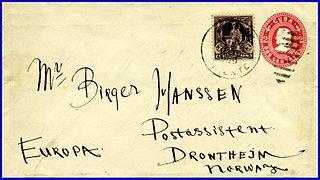
A stamped envelope or postal stationery envelope (PSE) is an envelope with a printed or embossed indicium indicating the prepayment of postage. It is a form of postal stationery.

Postage stamps and postal history of Great Britain surveys postal history from the United Kingdom and the postage stamps issued by that country and its various historical territories until the present day.
The Penny Post is any one of several postal systems in which normal letters could be sent for one penny. Five such schemes existed in the United Kingdom while the United States initiated at least three such simple fixed rate postal arrangements.

In philately, a perfin is a stamp that has had initials or a name perforated across it to discourage theft. The name is a contraction of perforated initials or perforated insignia. They are also sometimes called SPIFS.
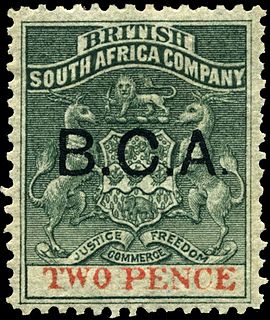
The British Central Africa Protectorate existed in the area of present-day Malawi between 1891 and 1907.

Postal services in New Zealand have existed since at least 1831, when the Postmaster-General of New South Wales deputed a Bay of Islands merchant to receive and return mail. Governor William Hobson issued an ordinance covering postal matters, although the British government retained control until 1848.

In philatelic terminology a letter sheet, often written lettersheet, is a sheet of paper that can be folded, usually sealed, and mailed without the use of an envelope, or it can also be a similar item of postal stationery issued by a postal authority. Letter sheets derive from the form in which written correspondence was made up before the mid-19th century — letters were written on one or more sheets of paper that were folded and sealed in such a way that the address could be written on the outside.

Mauritius, a small island in the southwest Indian Ocean, is of towering importance in the world of philately for a number of reasons. Its first two postage stamps issued in 1847, called the "Post Office" stamps, are of legendary rarity and value. They were the first stamps issued in any part of the British Empire outside of Great Britain. The unique cover bearing both “Post Office” stamps has been called "la pièce de résistance de toute la philatélie" or "the greatest item in all philately". The cover was sold at auction, in Zurich, on 3 November 1993, for 5.75 million Swiss francs, the equivalent of about $4 million – the highest price ever paid for a single philatelic item up to that time. In addition, Mauritius is well known for the subsequent locally produced issues known as "primitives," also prized by collectors.

A specimen stamp is a postage stamp or postal stationery indicium sent to postmasters and postal administrations so that they are able to identify valid stamps and to avoid forgeries. The usual method of invalidating the stamps is either overprinting in ink or perforating the word Specimen across the stamp and where English is not the common language, the words Muestra (Spanish), Monster (Dutch), Muster (German) or Образец have been used instead.

This is a survey of the postage stamps and postal history of Gibraltar.

The Gibraltar Study Circle exists to study the stamps and postal history of Gibraltar, a British overseas territory located at the entrance to the Mediterranean Sea overlooking the Strait of Gibraltar.
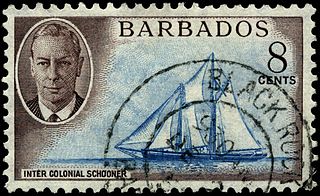
This is a survey of the postage stamps and postal history of Barbados.
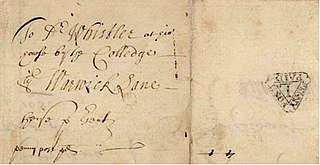
The Fletcher Collection is Hugh Greenwell Fletcher's lifetime philatelic collection of British postage stamps and British stamps used abroad including overprints and non-stamp items such as postal stationery. On his death in 1968, the collection was bequeathed to the Bruce Castle Museum in Tottenham, once the home of Sir Rowland Hill. The collection was donated to the British Library in 1989.
The Postal Stationery Society of Great Britain was formed in April 1941, with the aim of encouraging philatelists to collect and study postal stationery, in addition to the accepted hobby of stamp collecting. The Society had about 20 members in the beginning, some of whom carried out detailed research on issues of postal stationery from many different postal administrations, while others sent in questions on material they had bought and would like to find out more. All this was reported in the Society’s newsletters which were issued 2 or 3 times per annum in the early years, and more frequently later on. The newsletters were duplicated sheets of paper, initially one foolscap sheet for each issue, although this later became two sheets per issue. Copies of these newsletters are held in the libraries of the Postal Stationery Society and the Royal Philatelic Society London.

















